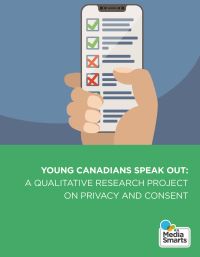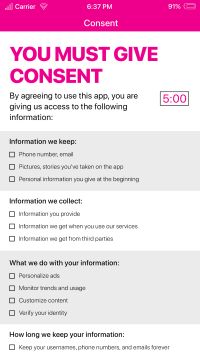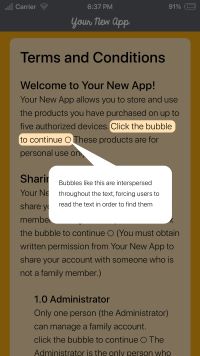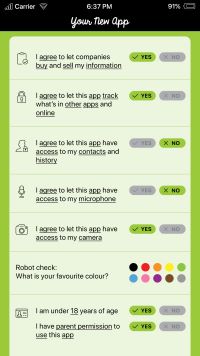Young Canadians Speak Out: A Qualitative Research Project on Privacy and Consent
MediaSmarts conducted focus groups with young Canadians ages 13 to 16 in Ottawa, giving them the chance to consider, discuss and design ways of obtaining consent online that are clear and meaningful to them. As part of the focus groups, youth were asked to share their thoughts on and experiences with current online consent processes. They were then asked to come up with hand-drawn ‘paper prototypes’ of their ideal privacy policies. The findings, highlighted in the report Young Canadians Speak Out: A Qualitative Research Project on Privacy and Consent, offered creative new ideas on how platforms can improve online consent processes – not just for young people, but for everyone – so Canadians can better understand what they’re agreeing to when it comes to their privacy.
 Youth want clear and simple online privacy policies to better understand online consent
Youth want clear and simple online privacy policies to better understand online consent
The stereotype goes that youth don’t care about their privacy when it comes to sharing content and personal data online. But recent conversations with youth about their attitudes on data privacy, specifically when it comes to terms and conditions for apps and platforms, show that young Canadians are concerned about what they’re actually consenting to when they click “I Agree.”
The youth we spoke to during focus groups want more information, more control and more transparency from online platforms. They also have a desire to actively participate in the re-imagining and re-designing of the processes behind the data collection that will affect their lives.
As part of the focus groups, the youth (ages 13 to 16) were asked to share their thoughts on and experiences with current online consent processes. They were then asked to come up with hand-drawn ‘paper prototypes’ of their ideal service policies.
The results offered creative new ideas on how platforms can improve online consent processes – not just for young people, but for all of us – so we can better understand what we’re agreeing to when it comes to our privacy.
Here are the main issues the youth pointed to:
TOO LONG; NEVER READ
Not surprisingly, the youth we spoke to said they don’t read the long and complicated terms of service documents that come with downloading a new app or using a new platform. Most adults do the same.
“…for the most part I often find myself just being like, ‘Yeah ok, I agree. I agree to whatever is going on here.” – Bianca, 16
“I feel like people would read it if it was worded better and to the point instead of all these words that no one understands.” – James, 16
UNANTICIPATED AUDIENCES AND CONSEQUENCES
Some youth were shocked by the possible consequences of data collection, especially the fact that their data profile might impact future employment opportunities.
“Barely anyone in this room actually knew that whether or not they got a job would be based on the websites we visit. So especially that point should be advertised more.” – Andrew, 16
They expressed a desire to have the ability to wipe their data slate clean, saying it wasn’t fair that something they do online when they are young can follow them for the rest of their life.
‘SKETCHY’ AND ‘WEIRD’ CONSENT POLICIES AND PRACTICES
Youth used descriptors like ‘sketchy and ‘weird’ to describe how data is collected and brokered online. They questioned why companies don’t have a mechanism to ensure that you’ve read the policies.
Location tracking was singled out as having the potential to be particularly creepy. Youth agreed it could be useful in identifying general things like recommendations for where to shop, but said they should have to opt-in to location settings rather than discover they’re being tracked unknowingly.
“There’s a feature on your phone that says where you’ve been, what mode of transportation you’ve been on, how long you were there for… I don’t remember signing up for that.” – Shannon, 16
Youth also noted “you have to consent to too much at once” and would prefer to have the option to opt-in to certain features and opt-out of others.
Generally they weren’t opposed to data collection, but wanted more clarity and control and for corporations to not take and use data without their explicit consent.
Here are some proposed solutions the youth came up with:
The new paper prototypes they developed during the focus groups offer several different strategies and features to improve accessibility, and to prove that users understand what they’re agreeing to.
ACCESSIBILITY:
- Use clear, plain and simple language
- Use short sentences and paragraphs to summarize important information
- Match the age and reading comprehension levels of users so it’s easier to understand
- Make use of headings and bullet points, and use bold, underlined and colourful text
- Use videos and graphics alongside text
SHOWING USERS HAVE READ AND UNDERSTOOD:
- Make sure users are actually reading, listening to or watching the privacy and consent features by using interactive components, like line-by-line checkmark boxes and timers

- Use a ‘sandwich method’ where the user reads the documents before filling out personal info, then confirms again before finishing the sign-up process
- Hide ‘Easter eggs’ within the text so that users need to read the whole thing in order to find out where to click to confirm consent

CLARITY AND CONTROL:
- Allow users to ‘unbundle’ their consent options by using a toggle feature to choose which specific items they’re consenting to

- Use pop-ups to remind users of the privacy and consent policies as they are interacting with different features within the platform, so they can decide to turn it on or off on an ad hoc basis
Read the entire report here, and read our recommendations for platforms here.
This research was made possible by the financial contributions from the Office of the Privacy Commissioner of Canada’s contributions program.
